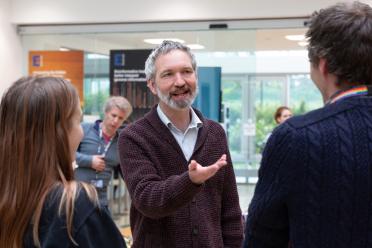Assembly line: making sense of metagenomics through MAGs
Etiquette for microbes, non-viral gastroenteritis, and shotgunning DNA are all in a day’s work for Dr Chris Quince.
High-Resolution Microbiomics Group Leader at the Earlham Institute and Quadram Institute, Dr Quince is leading a key strand of our Decoding Biodiversity research programme.
In it, he is applying newly-developed tools to microbiomes for a better look at the links between ecosystem function and microbial diversity.
We talked to him about his research interests, Pakistan’s water supply, and complex microbiomes.
Microbes live in diverse communities, interacting with and influencing each other. They might pass antimicrobial resistance genes between species, compete for food sources, or live commensally - for example, if one species lives off the waste products of another.
Studying these dynamics is crucial to understanding how microbes are affected by changes to their environment - and how changes to their lives, in turn, might affect ours.
“Historically speaking, we’ve not looked much beyond the species level when analysing micro-organisms,” says Dr Quince. “We’re missing a great deal by not examining what happens when these organisms interact with each other.
“This has the potential to be transformative in how we look at complex microbial communities.”
Dr Quince’s research at the Institute focuses on metagenomic analysis of microbiomes, including carrying out large-scale data analyses and developing new techniques for metagenome strain resolution.

Genomics examines complete genetic information from a single organism, while metagenomics explores a mixture of complete genetic information from multiple organisms.
Metagenomics is useful for exploring microbiomes - varied communities of cohabiting microorganisms - and, depending on the origin of the microbiome, samples can include bacteria, archaea, free DNA, fungi, viruses, and viroids.
In metagenomic microbiome sequencing, DNA is extracted from all cells in a community and sheared into fragments. It is then reconstructed using sophisticated computational approaches, aligning the DNA to genomic locations for all genomes present in the sample. These metagenome assembled genomes (MAGs) can then be analysed.
Dr Quince has used these techniques in his research, which has included analysing data from trials of new treatments for paediatric Crohn’s disease and understanding what drives antimicrobial resistance (AMR) in the gut microbiome.
His most recent publication focuses on ‘collateral damage’ to the microbiome from antibiotics. The number of resistance genes being passed back and forth between strains in the microbiome increases with use of the drugs.
The findings also suggest these genes spread so easily through a population that, regardless of your own health and habits, the number of resistance genes in your gut is heavily influenced by national trends in antibiotic consumption.
Further research is planned to investigate the relationship in more countries and inform public health strategies.


Historically speaking, we have not looked much beyond the species level when analysing micro-organisms. We are missing a great deal by not examining what happens when these organisms interact with each other.

Dr Chris Quince, Group Leader at the Earlham Institute and Quadram Institute
A key research project is GastroPak, a Global Challenges Research Fund-supported initiative that aims to determine sources of non-viral gastroenteritis in Pakistan.
Gastroenteritis is an infection of the stomach and small intestine, causing diarrhoea and dehydration, and can be deadly in countries where access to clean water is limited.
“There are major transmission rates of gastroenteritis in Pakistan,” explains Dr Quince.
“This comes about in a number of ways - limited clean water, irrigation of vegetables and crops with wastewater, and spreading within households.
“We’re attempting to detect some of the pathogens responsible by comparing household and environmental data. There have been some intriguing results so far, although it’s too early to say anything conclusive.”
This interdisciplinary project involves working closely with researchers in Pakistan and communities on the ground. It brings together social scientists, microbiologists, engineers, epidemiologists, chemists, and statisticians to develop the capacity for pathogen surveillance. The team is investigating how different factors such as agriculture, sanitation, and drinking water contribute to the spread of infection.
Real-world understanding of communities and behaviours, coupled with the shared expertise of Dr Quince and his collaborators in Pakistan, will allow researchers to better understand the dynamics of infection.

Dr Quince started his career as a PhD student in Theoretical Physics, studying ecosystem models at the University of Manchester. Following time in Arizona and Toronto, he took up a fellowship to model microbial communities at the University of Glasgow.
Intrigued by the potential of next generation sequencing to profile microbiomes, Dr Quince taught himself bioinformatics and went on to demonstrate that ‘sequencing noise’ was creating huge amounts of diversity in apparently simple microbial communities.
This inspired him to develop some of the first tools for removing noise from amplicon sequences, giving far more accurate estimates of diversity in a wide range of microbial communities.
Dr Quince has pioneered techniques to reduce sequencing noise and the application of methods such as shotgun metagenomics to microbial communities.